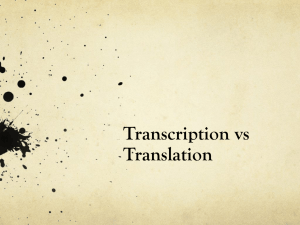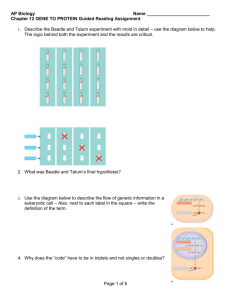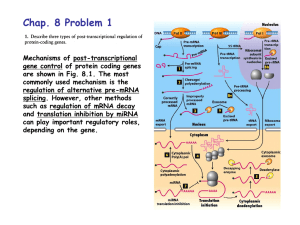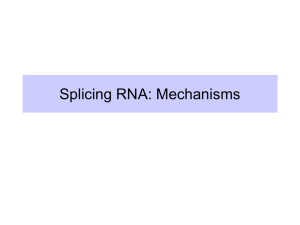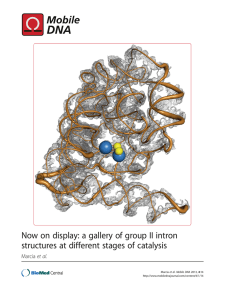Kevin Ahern's Biochemistry (BB 451/551) at Oregon State University
advertisement
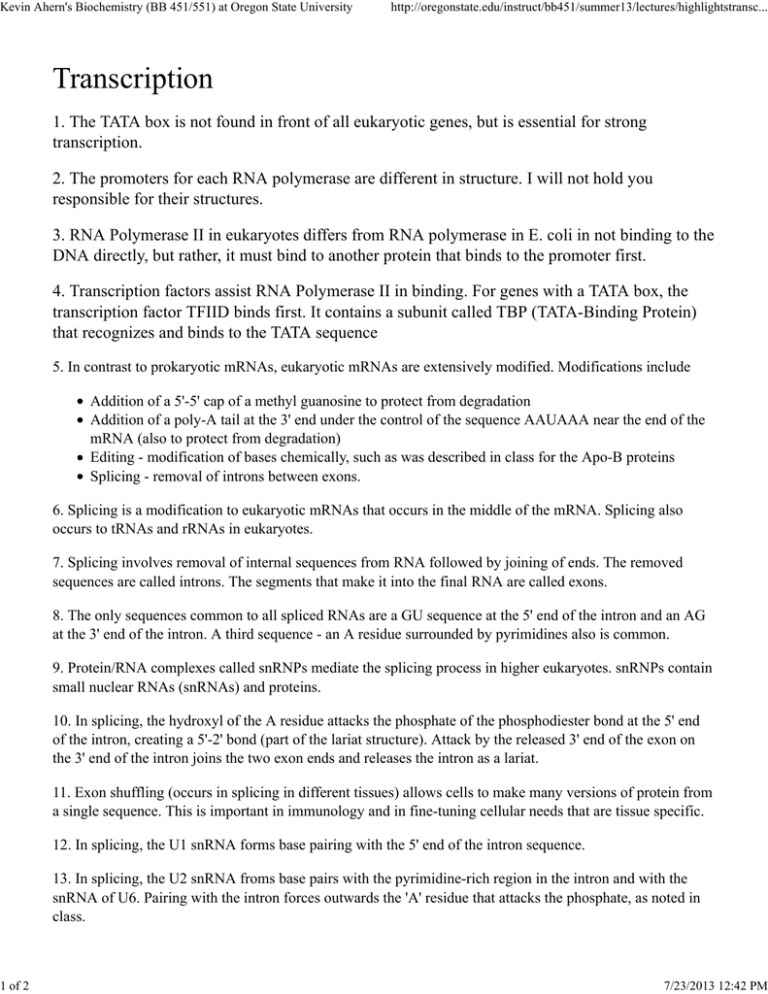
Kevin Ahern's Biochemistry (BB 451/551) at Oregon State University http://oregonstate.edu/instruct/bb451/summer13/lectures/highlightstransc... Transcription 1. The TATA box is not found in front of all eukaryotic genes, but is essential for strong transcription. 2. The promoters for each RNA polymerase are different in structure. I will not hold you responsible for their structures. 3. RNA Polymerase II in eukaryotes differs from RNA polymerase in E. coli in not binding to the DNA directly, but rather, it must bind to another protein that binds to the promoter first. 4. Transcription factors assist RNA Polymerase II in binding. For genes with a TATA box, the transcription factor TFIID binds first. It contains a subunit called TBP (TATA-Binding Protein) that recognizes and binds to the TATA sequence 5. In contrast to prokaryotic mRNAs, eukaryotic mRNAs are extensively modified. Modifications include Addition of a 5'-5' cap of a methyl guanosine to protect from degradation Addition of a poly-A tail at the 3' end under the control of the sequence AAUAAA near the end of the mRNA (also to protect from degradation) Editing - modification of bases chemically, such as was described in class for the Apo-B proteins Splicing - removal of introns between exons. 6. Splicing is a modification to eukaryotic mRNAs that occurs in the middle of the mRNA. Splicing also occurs to tRNAs and rRNAs in eukaryotes. 7. Splicing involves removal of internal sequences from RNA followed by joining of ends. The removed sequences are called introns. The segments that make it into the final RNA are called exons. 8. The only sequences common to all spliced RNAs are a GU sequence at the 5' end of the intron and an AG at the 3' end of the intron. A third sequence - an A residue surrounded by pyrimidines also is common. 9. Protein/RNA complexes called snRNPs mediate the splicing process in higher eukaryotes. snRNPs contain small nuclear RNAs (snRNAs) and proteins. 10. In splicing, the hydroxyl of the A residue attacks the phosphate of the phosphodiester bond at the 5' end of the intron, creating a 5'-2' bond (part of the lariat structure). Attack by the released 3' end of the exon on the 3' end of the intron joins the two exon ends and releases the intron as a lariat. 11. Exon shuffling (occurs in splicing in different tissues) allows cells to make many versions of protein from a single sequence. This is important in immunology and in fine-tuning cellular needs that are tissue specific. 12. In splicing, the U1 snRNA forms base pairing with the 5' end of the intron sequence. 13. In splicing, the U2 snRNA froms base pairs with the pyrimidine-rich region in the intron and with the snRNA of U6. Pairing with the intron forces outwards the 'A' residue that attacks the phosphate, as noted in class. 1 of 2 7/23/2013 12:42 PM Kevin Ahern's Biochemistry (BB 451/551) at Oregon State University http://oregonstate.edu/instruct/bb451/summer13/lectures/highlightstransc... Translation 1. Translation is performed by ribosomes on mRNA and occurs in the 5' to 3' direction. The rate of translation in bacteria is about the same as the rate of transcription (45-50 bases or 15-17 amino acids per second). The 5' end of the coding region corresponds to the amino end of the protein. The 3' terminus of the coding region corresponds to the carboxyl end of the protein. 2. Translation is performed by ribosomes on mRNA and occurs in the 5' to 3' direction. The rate of translation in bacteria is about the same as the rate of transcription (45-60 bases or 15-20 amino acids per second). The 5' end of the coding region corresponds to the amino end of the protein. The 3' terminus of the coding region corresponds to the carboxyl end of the protein. 2 of 2 7/23/2013 12:42 PM

